
REVIEW – In my never-ending quest to always be prepared for any eventuality I’ve accumulated quite a few portable power units. Large and small, these power packs are strewn about my apartment, stored in pockets and backpacks, or stashed away in bins patiently awaiting the apocalypse. None of the many battery packs I own though come close to the sheer power and functionality of the Goal Zero Yeti 1000 Core Portable Power Station. The Yeti 1000 Core is a scaled-down version of its big brother the Yeti 1000X and is available through an exclusive partnership with Amazon. Due to a slightly reduced feature set, the Yeti 1000 Core comes in $300 lower than the 1000X at the outstanding price of $999.95. By removing some of the bells and whistles that appeal mostly to expert users, Goal Zero has created an impressive affordable power station with mass appeal.
What is it?
The Goal Zero Yeti 1000 Core Portable Power Station is a lithium-ion battery-powered unit capable of powering small appliances up to and including refrigerators and air conditioners. The Yeti 1000 Core can also charge pretty much any device that connects via USB-C, USB-A, 12V car charger, standard AC, and a few other proprietary plugs.
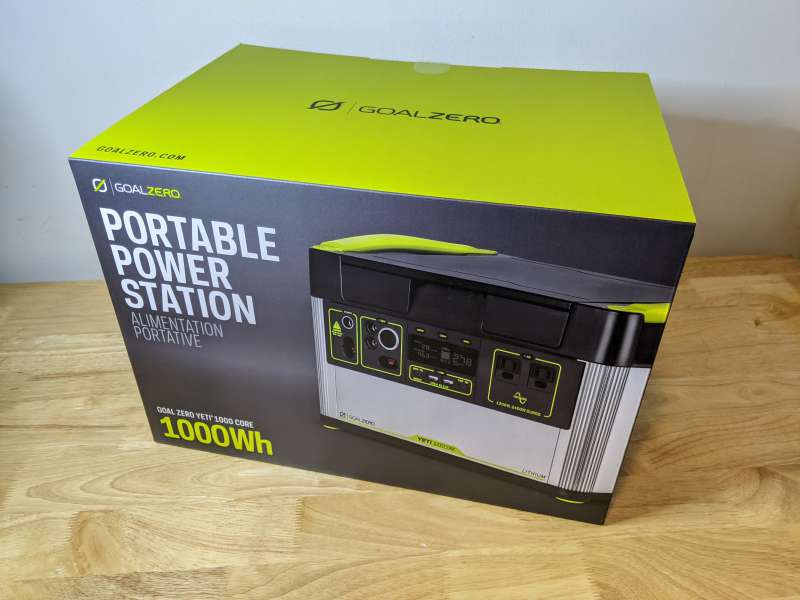
The Yeti 1000 Core arrives from Amazon in a very sturdy, well-designed box highlighted with Goal Zero’s signature bright green and detailing many of the specifications and features of the power station.
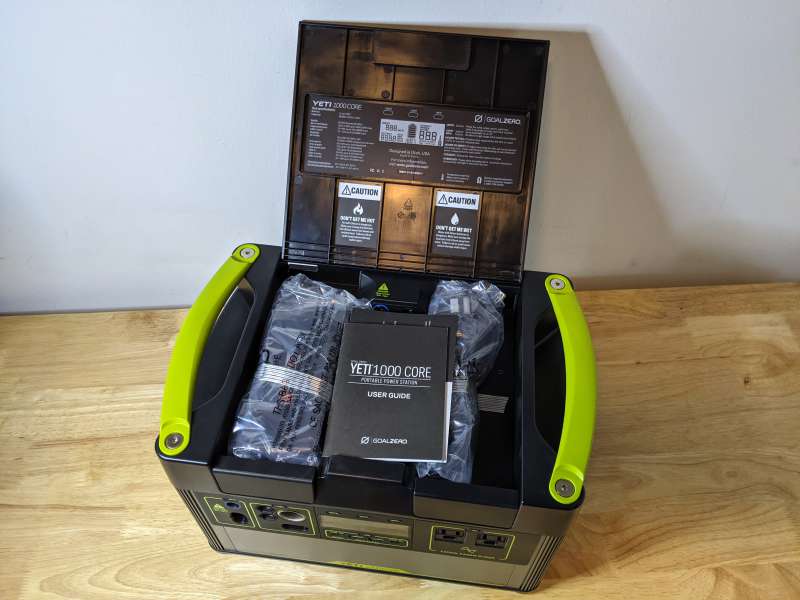
The accessories for the Yeti 1000 Core ship securely inside the storage section of the unit itself.
What’s in the box?
- Goal Zero Yeti 1000 Core Portable Power Station
- Power supply
- Power cable
- User Guide
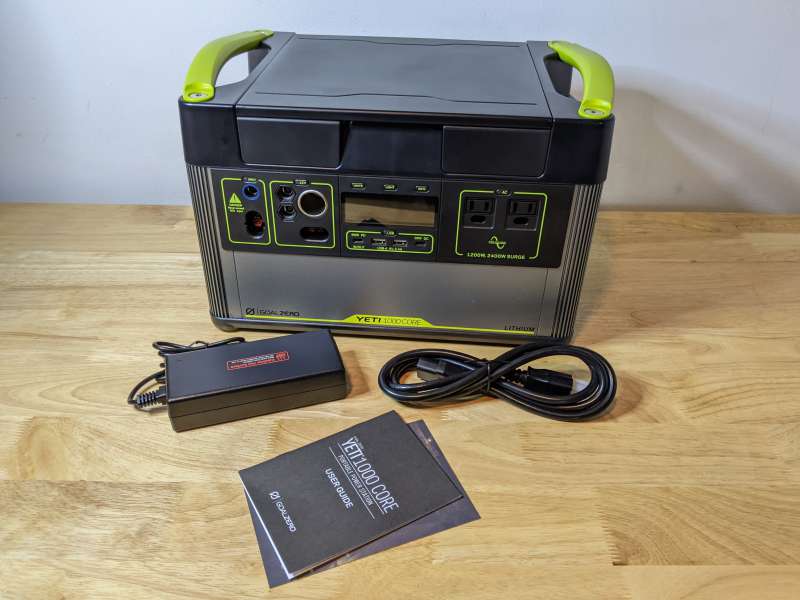
Hardware specs
- Battery Cell Type: Li-ion NMC (Lithium-ion Nickel Manganese Cobalt)
- Cell Capacity: 983Wh (10.8V, 91Ah)
- Single Cell Equivalent Capacity: 273Ah @ 3.6V
- Lifecycles: 500 Cycles to 80% capacity (Discharge rate: 1C, Full charge/discharge, Temp: 25C)
- Inverter Size: 1200W, 2400W surge
- Input Max: 300 Watts
- Shelf-life: Charge every 3-6 months
- Power Management System: Maximum Power Point Tracking (MPPT) charge controller
- Weight: 31.68 lbs (14.37 kg)
- Dimensions: 15.25 x 10.23 x 9.86 in (38.74 x 25.98 x 2504 cm)
- Operating Usage Temp: 32-104 F (0-40 C)
- Ports:
- 2 USB-A Ports (output): 5V, up to 2.4A (12W max), regulated
- 1 USB-C Port (output): 5-12V, up to 3.0A (18W max), regulated
- 1 USB-C PD Port (input/output): 5-20V, up to 3.0A (60W max), regulated
- 3 6mm Ports (output, 6mm): 12V, up to 10A (120W max), regulated
- 1 12V Car Port (output): 12V, up to 15A (180W max), regulated
- 1 High Power Port (HPP) (output): 12V, up to 15A (180W max), regulated
- 1 High Power Port (HPP) (input): 14-50V, up to 50A (300W max)
- 2 120V AC Ports (output, pure sine wave): 120VAC 60Hz, 10A (1200W, 2400W surge)
- 2 Charging Ports (input, 8mm): 14-50V, up to 10A (150W max)
- Charge times:
- Wall Charger (120W): 9 hrs
- Car Charger (120W): 9 hrs
- Goal Zero Boulder 50: 24-48 hrs
- Goal Zero Boulder 100: 12-24 hrs
- Goal Zero Boulder 200 briefcase: 6-12 hrs
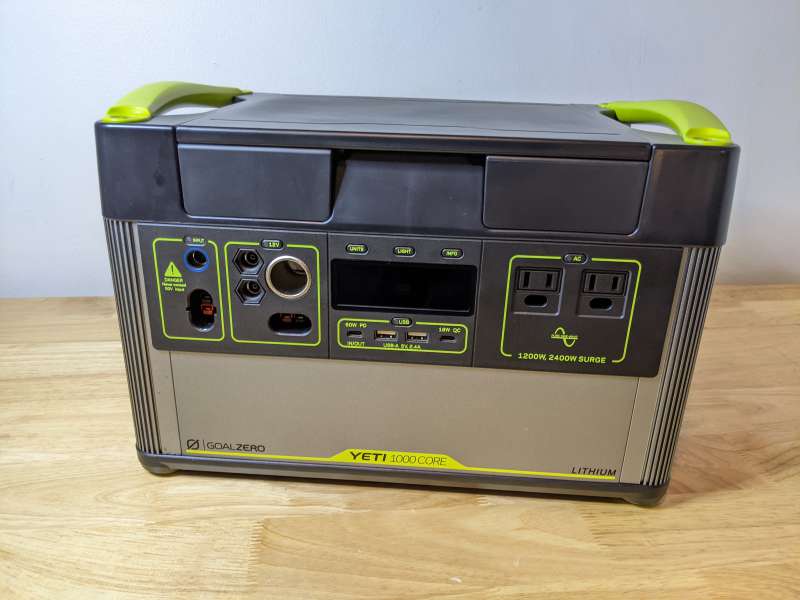
Design and features
The Yeti 1000 Core is the same size and design as the more powerful Yeti 1000X but intentionally has reduced features to get the price down to $999.95. Unlike the $1299.95 Yeti 1000X, the Yeti 1000 Core has no support for Yeti Link, which allows battery expansion, has a slightly less powerful AC inverter, and has a 300W charging input as opposed to the 1000X’s 600W. The 1000 Core also isn’t compatible with the Goal Zero Yeti App which is found on other high-end units like the 1500x and 3000x. None of these caveats should prevent anyone except the most hardcore users from seeing how great this power station is though.
The tweaks made to lower the price point for the Yeti 1000 Core were chosen wisely by Goal Zero to only be of concern to expert users who would be opting for the expanded features of the Yeti 1000x, 1500x, or 3000x anyway. The Yeti 1000 Core is just that, a unit that delivers on the core promise of a portable power station, to deliver power efficiently and reliably without all of the expensive advanced frills required by expert users.
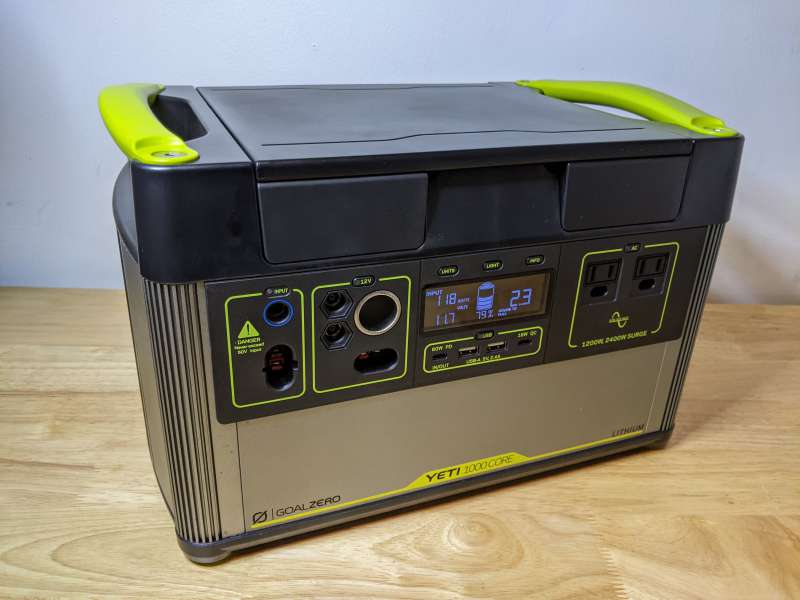
As for the build of the Yeti 1000 Core, it’s centered around that great, rugged aluminum body most Goal Zero devices are known for.
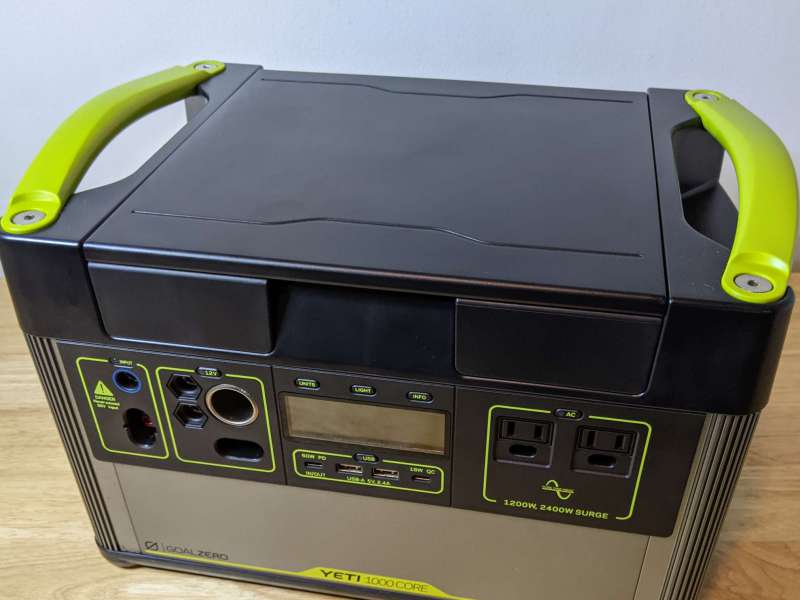
The top and face of the Yeti 1000 Core are black plastic with two signature green carry handles on either side bolted securely to the aluminum frame.
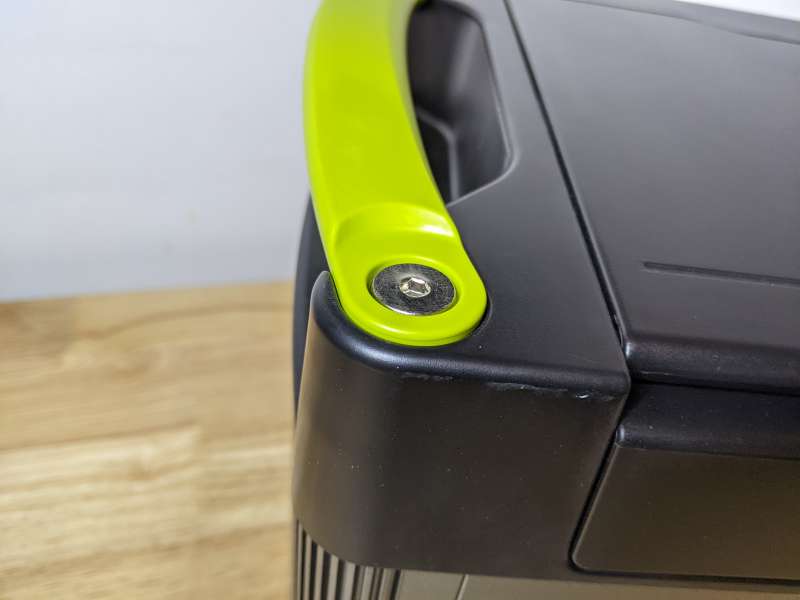
A great feature of all the Goal Zero 1000 units is that the notches on the side handles correspond to the rubber feet on the bottom allowing the power stations to be securely stacked.
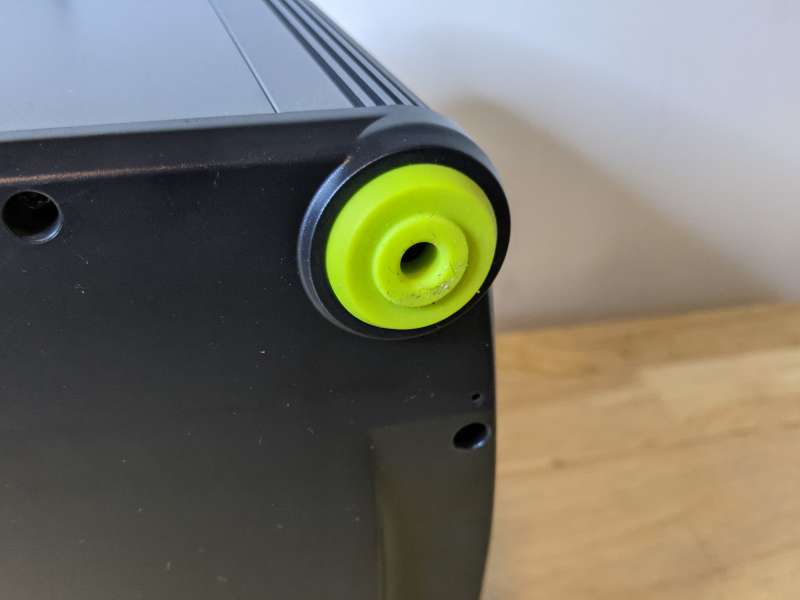
The corners of the Yeti 1000 Core have the standard Goal Zero ribbing cut into the aluminum frame to help with cooling.
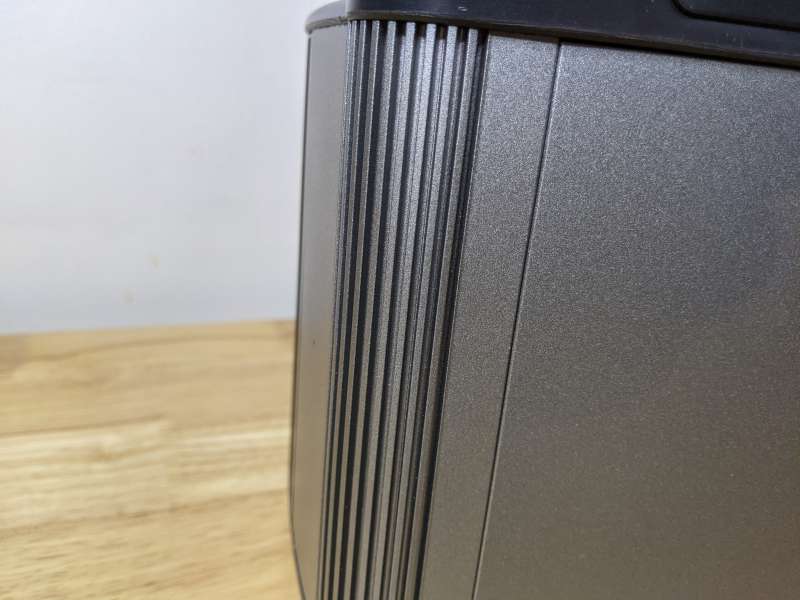
To further assist in preventing the unit from overheating, two powerful fans are embedded behind a plastic vent on one side of the Yeti 1000 Core.
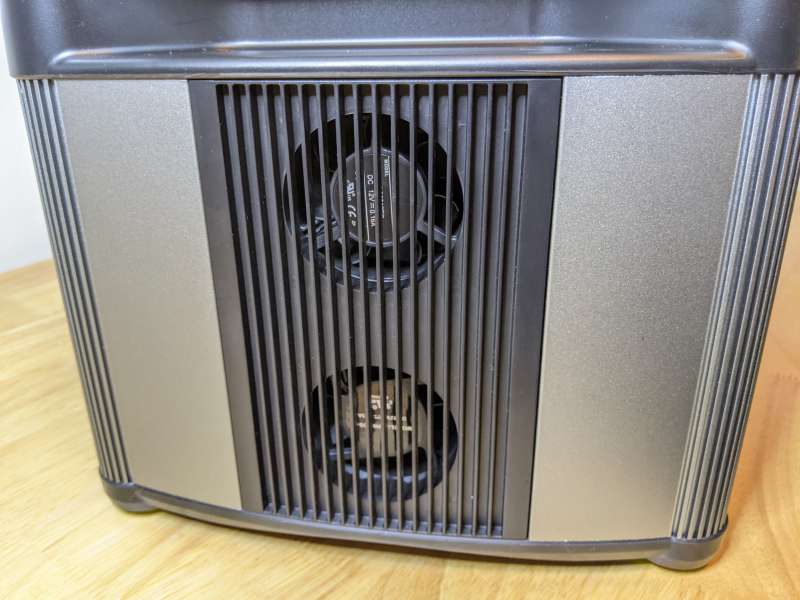
The back of the unit is black plastic as well and has a notch cut out to allow the power cable to run through it when stored inside the lid.
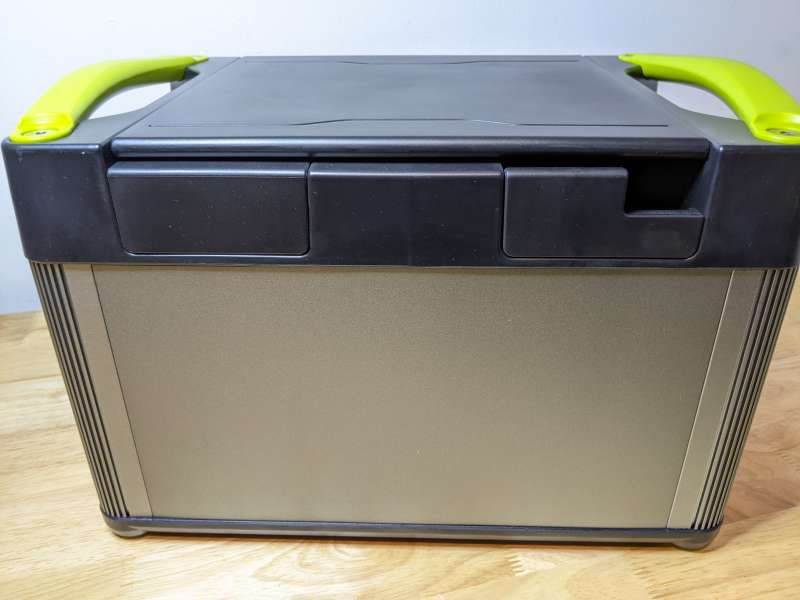
The storage space in the lid of the Yeti 1000 Core is another well-thought-out feature that really adds value and takes into account the needs of the average user.
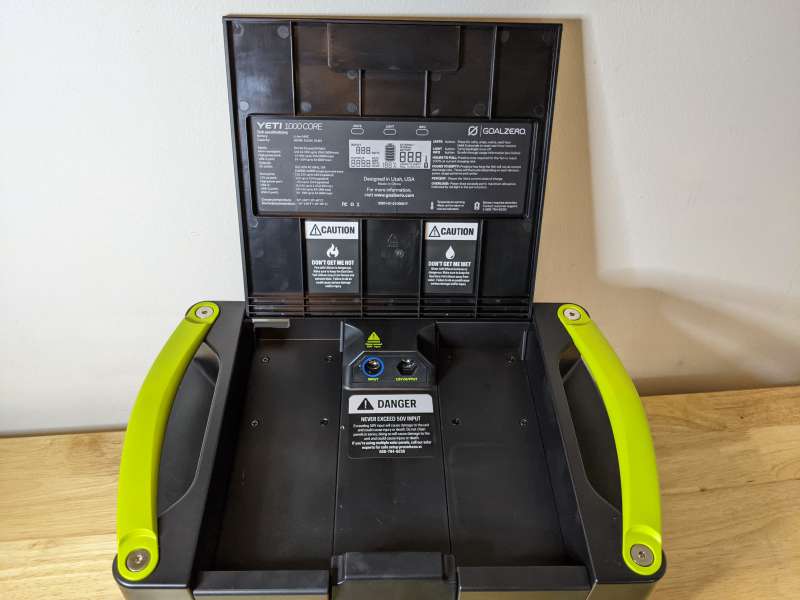
There’s plenty of room in here to store the Yeti 1000 Core power supply and cable along with any other charging cables or adaptors that may be needed.
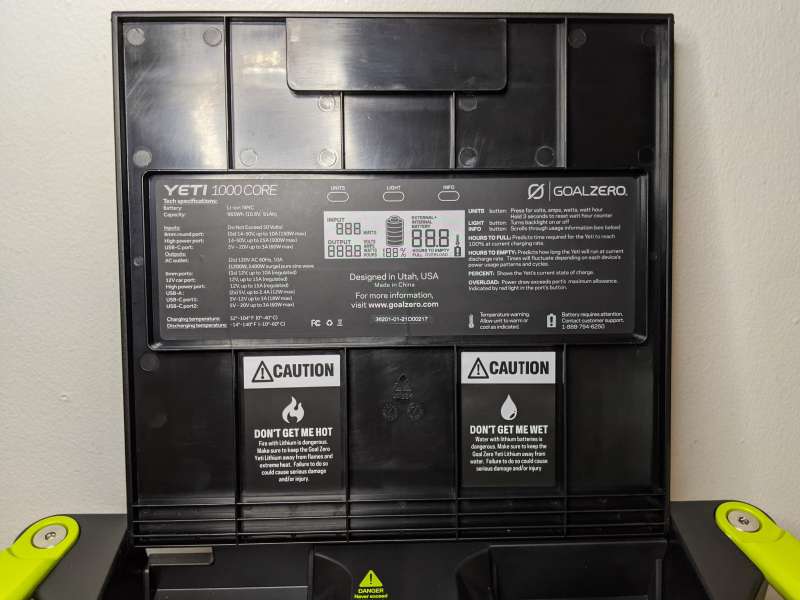
Printed inside the lid are basic instructions for the Yeti 1000 Core including how to read the front display, the specifications of the ports, and usage warnings.
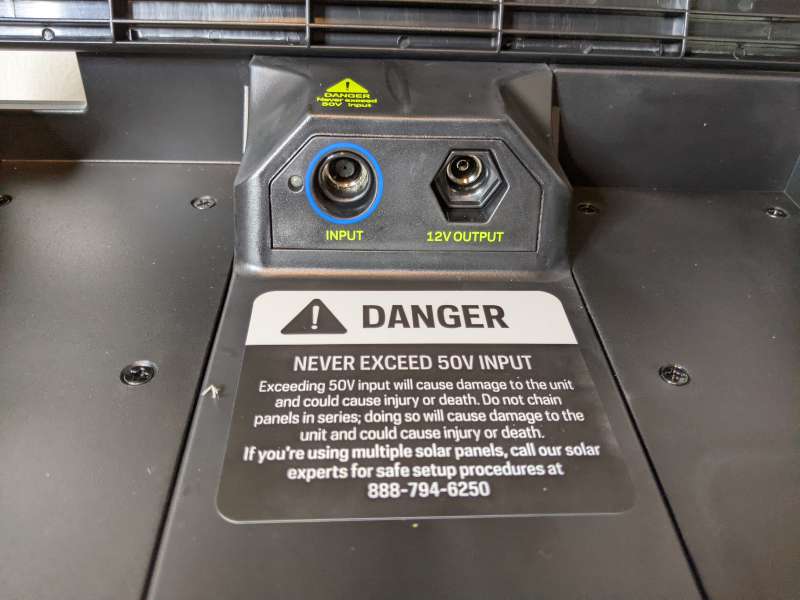
There are also two ports inside the storage space, one input for charging and one 6mm 12V output. Speaking of ports, the Yeti 1000 Core has a great selection, although I do wish there were a few more USB-A ports.
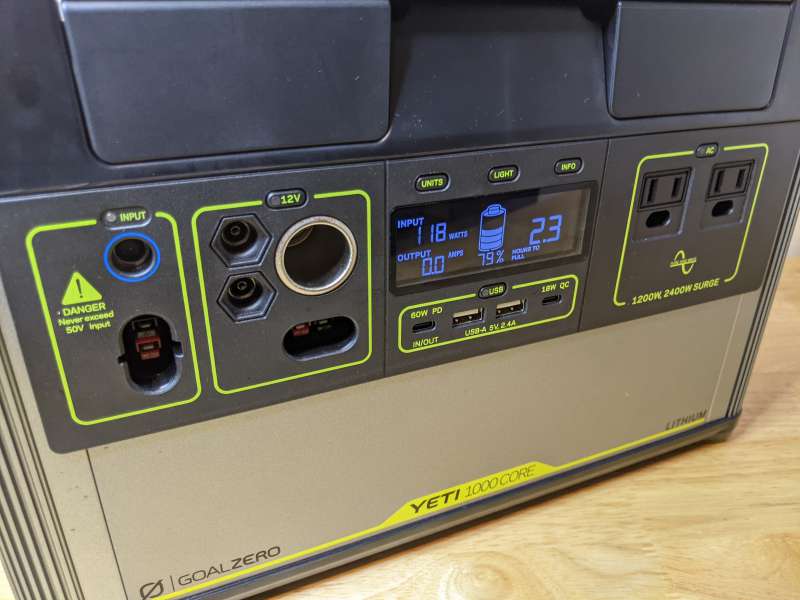
From left to right, there is a main charging port on the front in addition to the one in the storage unit; there’s a 12V section for car chargers and 6mm plugs; there’s a USB section with two USB-A ports and two USB-C ports, one of those also functioning as an input in case you ever need to charge the unit from a USB-C laptop charger; and of course, there are two 120-volt AC ports for larger devices.
With the multitude of open ports exposed on the front of the Yeti 1000 Core I did find myself checking them for dirt or debris a lot. This was mostly an issue during outdoor use and I think the unit could benefit from some basic plugs, at least to cover up the larger ports like the 12V Car Charger and the HPP ports.
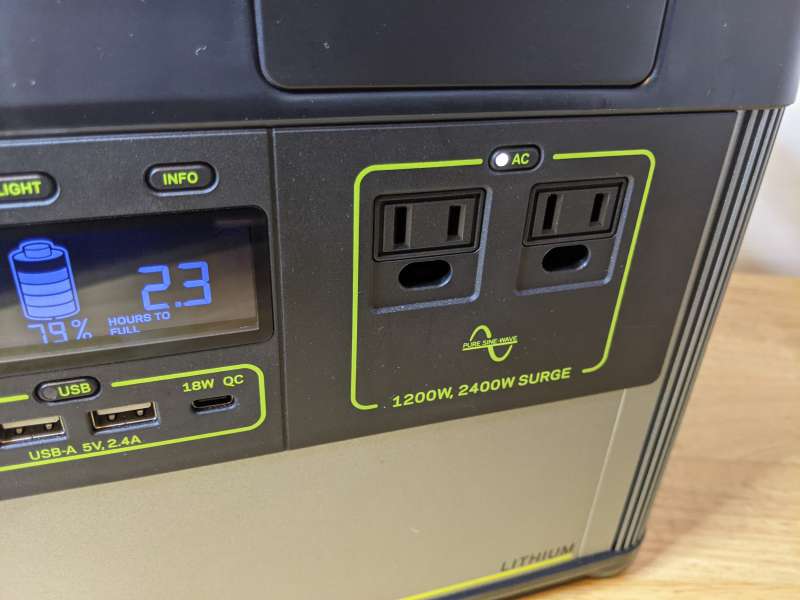
Each section of ports is activated by a small button above it which lights up when power to the ports is engaged. This is a great way to keep everything plugged in, but only send power to select devices.
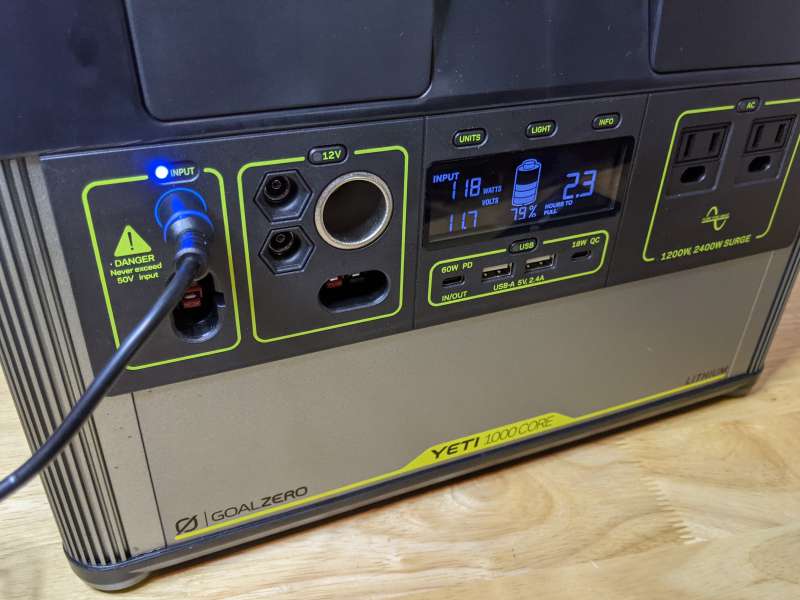
When the Yeti 1000 Core is being charged, the blue Input LED lights up whether you’re using the front power port or the one inside the storage unit.
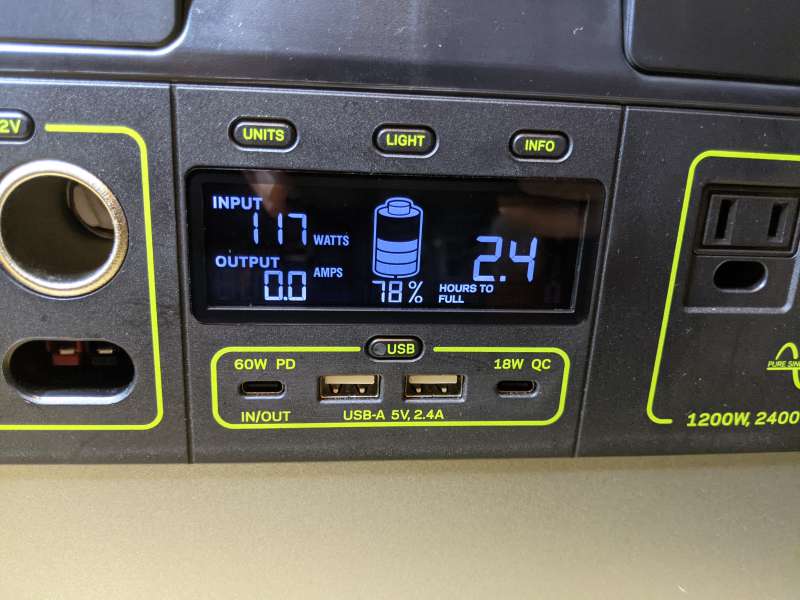
While charging, the front display informs on the amount of power being input, the current battery state, and an estimate on how long it will take the unit to fully charge.
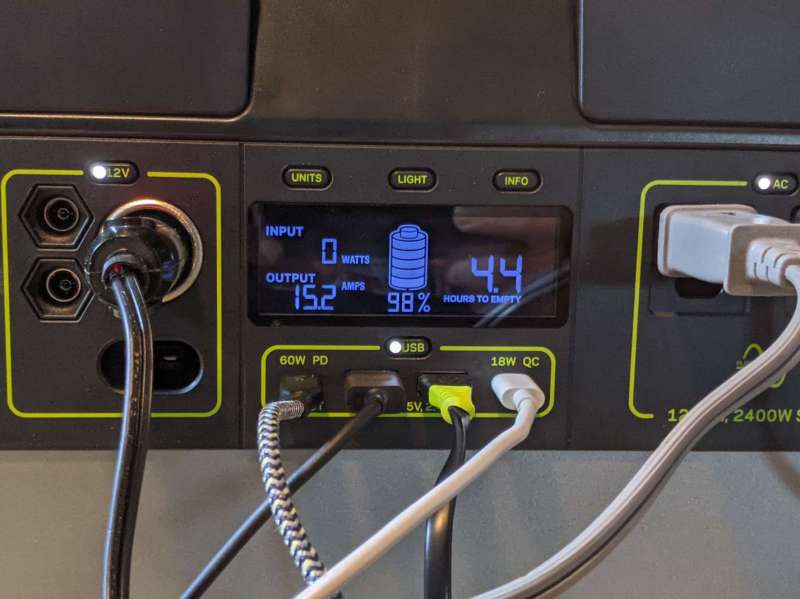
While discharging, the front display shows the same information but includes the amount of power being delivered to the attached devices, and the estimate switches to how long until the battery is empty. By clicking the Units button, you can cycle through different measurements of power like watts, watt-hours, volts, and amps. You can turn off the display any time with the Light button.
Setup
As with most Goal Zero power packs, the only setup needed is to fully charge the Yeti 1000 Core before using. My unit arrived with its battery about 78% full and it didn’t take very long to top it off before I was able to begin testing. As I mentioned, there are two main charging ports for the 1000 Core, I like to use the one located in the storage space to keep the clutter down since it’s one less thing plugged into the front of the unit.
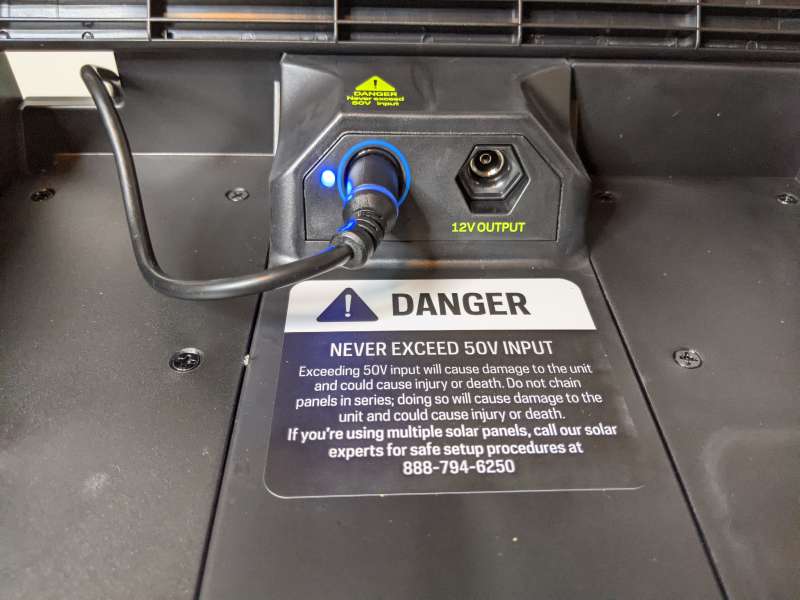
I charged my unit using the included 120W Wall Charger, but there are a number of ways to charge the Yeti 1000 Core including Goal Zero’s popular solar panels. One great thing about these newer Goal Zero Power Stations like the Yeti 1000 Core is that they have a built-in Maximum Power Point Tracking (MPPT) charge controller which ensures the unit is getting the most efficient solar charge possible, often increasing the efficiency by up to 40%. For Power Stations that don’t have an integrated MPPT charge controller, it’s available as an external add-on.
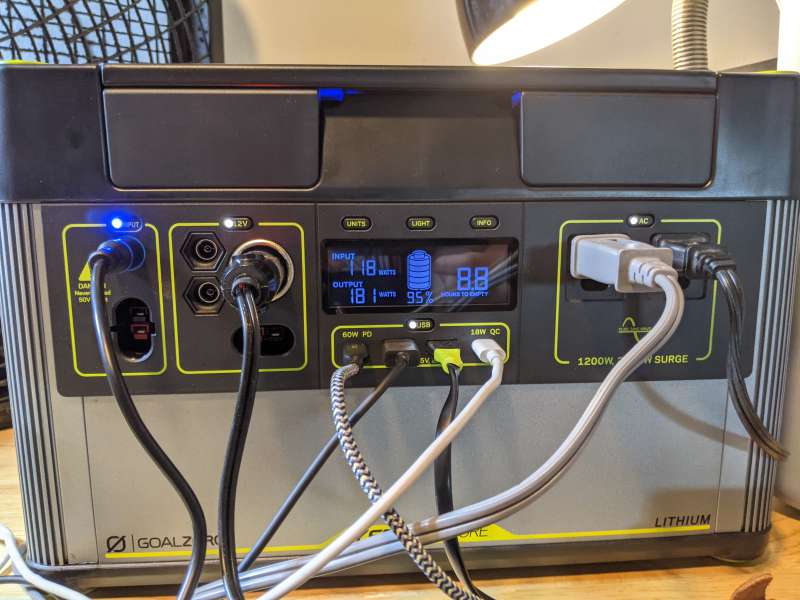
Performance
Once the Yeti 1000 Core was fully charged, I started plugging every power-hungry device I had laying around into it. Everything seen in the following pictures is being powered by the Yeti 1000 Core. I began with a few devices and then really piled it on to see how much the 1000 Core could handle. I tried to replicate the number and types of devices I might use on a trip where the Yeti 1000 Core would come in handy.
The biggest power drains were the large fan, reading lamp, and the AstroAI Electric Cooler I reviewed back in July. If you look closely you can see a few other devices I’ve reviewed like the Goal Zero Venture 75 Power Bank, the Zendure SuperTank Portable Charger, the Olight H2R Nova Flashlight, and my favorite device ever, the Nomad Tile Integrated PowerPack that I reviewed way back in April of 2017 and still goes everywhere with me.
I was thoroughly impressed by how the Yeti 1000 Core was able to charge everything that needed power while simultaneously running the fan and electric cooler nonstop for about 5 hours during this testing session. What was even more impressive was the precision of the display’s power estimate which was accurate to within a few minutes.
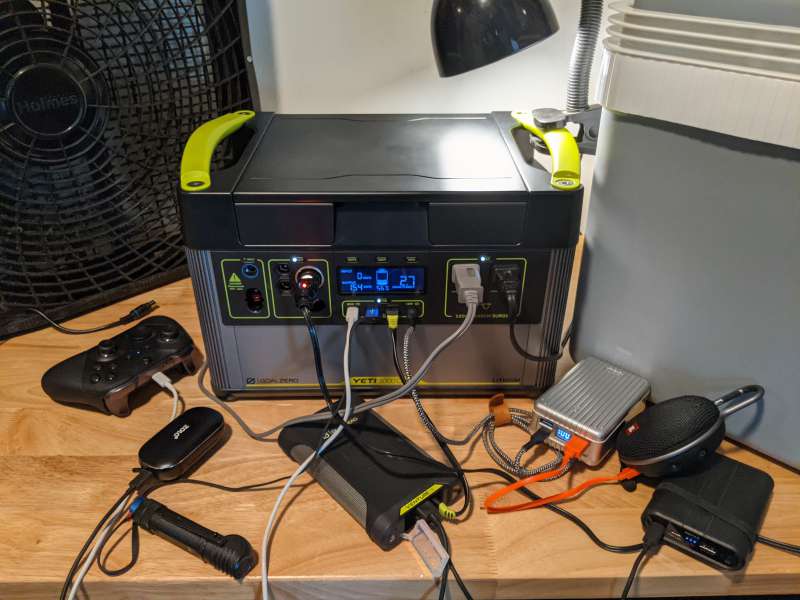
The Yeti 1000 Core stayed cool for the entire testing period and during the month where I toted it around in the back of my FJ using it to power everything from a portable air compressor to the Vankyo Portable Projector I reviewed in 2018. I think I was most surprised by how often I broke out the Yeti 1000 Core, which goes to show why having a feature-packed power station that’s reasonably priced makes such great sense. I think at this price more people will find value in having something like the Yeti 1000 Core around for all of life’s little emergencies that can be mitigated with a little portable power.
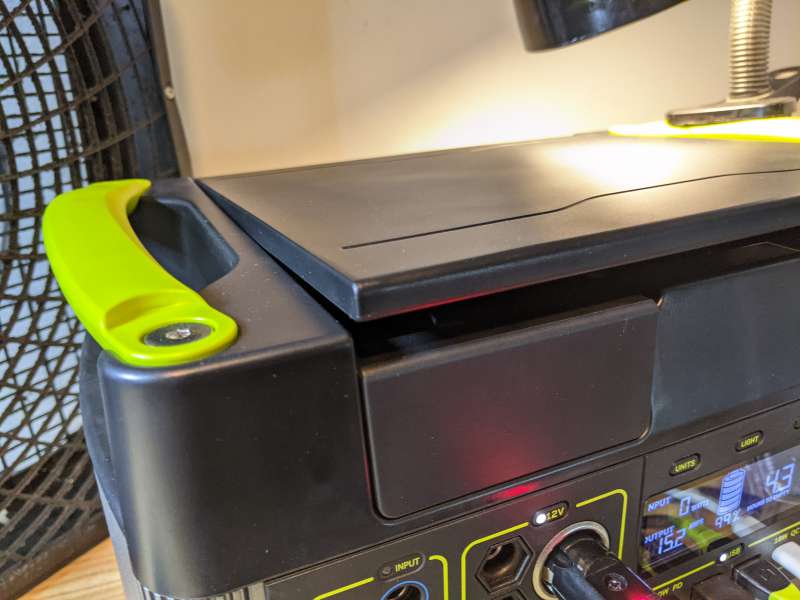
While testing, I was a little frustrated by the lid not staying closed. It normally secures with an embedded magnet but it kept popping open even though I often didn’t have many cords in there. A stronger magnet or latch would be great here but it’s by no means a deal-breaker.
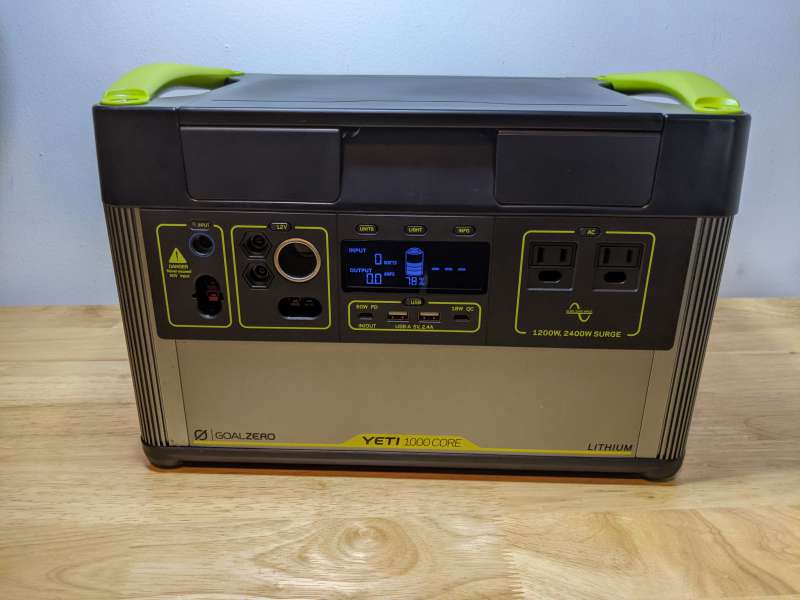
Overall, I really had a hard time finding negatives for the Yeti 1000 Core. Usually, with Goal Zero products my main gripe would always be that they are overpriced for what you’re getting, but that’s a nonstarter with the 1000 Core since it’s priced exactly where it should be.
What I like
- Great price for the feature set
- Outstanding design and usability
- Accurate power projections
What needs to be improved
- Lid should secure better
- Needs more USB-A ports
- Larger ports should have plugs
Final thoughts
The Yeti 1000 Core is the first Goal Zero product I’ve seen without a price tag that makes you feel as though you are paying a premium for the brand. This power station has all of the terrific design and feature notes Goal Zero is known for but at the great price of $999.95, which is right in line with its closest competitors. By removing some extra features and scaling back the specs offered on their higher-end units, Goal Zero has really hit a sweet spot with this unit. The exclusive partnership with Amazon for the Yeti 1000 Core offers up an impressive yet affordable power station that most users will find exceeds their expectations.
Price: $999.95
Where to buy: Amazon (save $100 with the Amazon coupon on the product page)
Source: The sample of this product was provided by Goal Zero



Gadgeteer Comment Policy - Please read before commenting
Unit fails to charge even after resetting and with charger giving the correct voltage.
Poor documentation